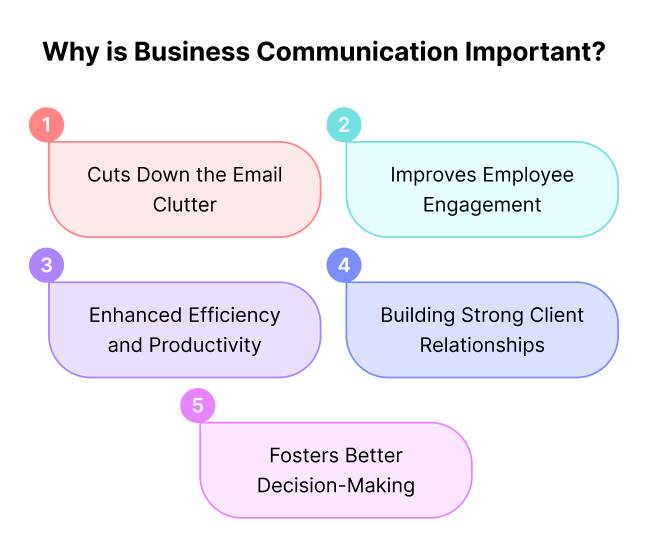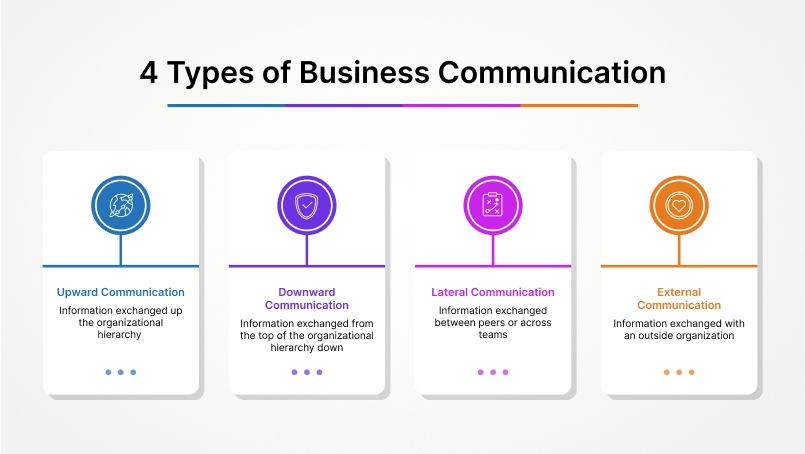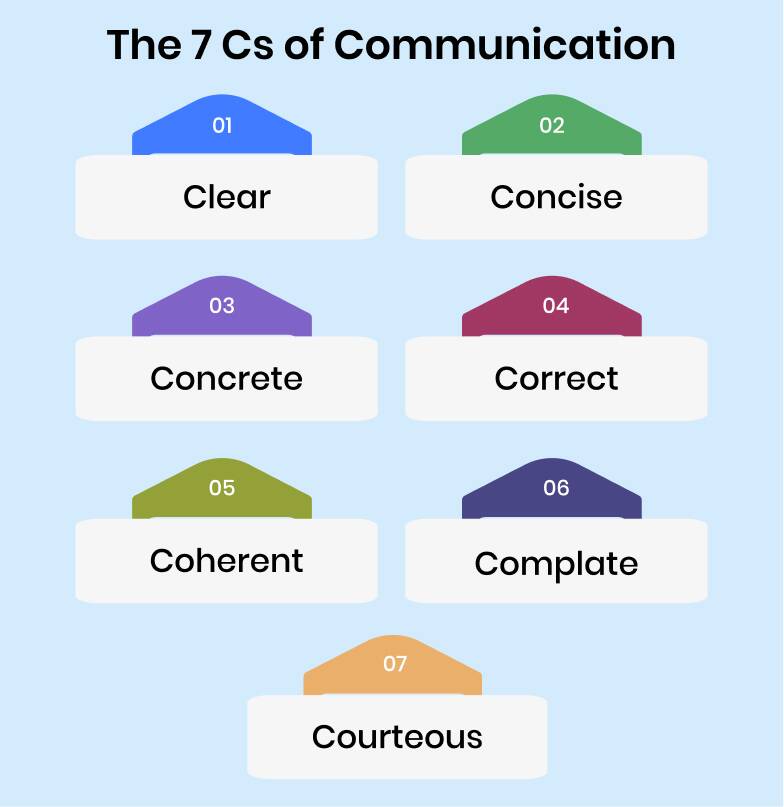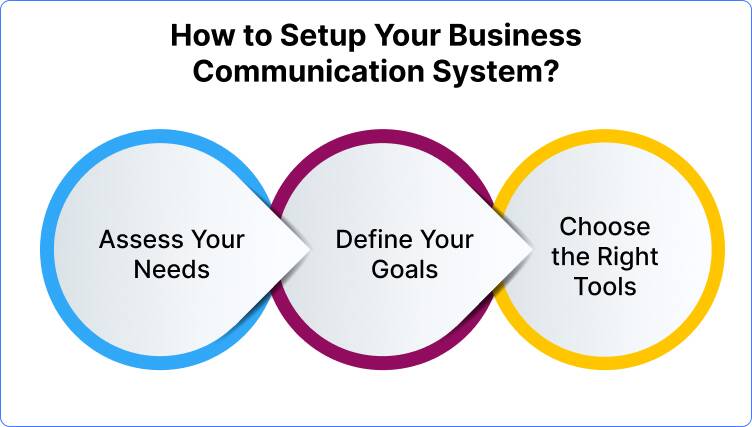
Have you ever walked out of a meeting confused or felt that the product team failed to communicate the features and benefits of a newly launched product to the sales team? You’re not alone. Studies show that poor communication costs businesses thousands of dollars a year. Also, a whopping 92% of business professionals believe effective communication is critical for their success (Source: Business Communication Institute). While we’ve all communicated in a business setting, what is business communication exactly, and why is it so crucial for success?
Satya Nadella, CEO of Microsoft, captures this perfectly:
“As a leader, communication is your most important job. You can have the right strategy, you can have the right people, but if you can’t articulate it and rally people around it, it’s not going to happen.”
(Source: Harvard Business Review)
Through this blog, we are going to deeply understand the meaning of business communication and its importance, along with some best practices for effective business communication.
Does it catch your attention? Let’s get started, folks!
What is Business Communication?
Business communication, or communication in the business, is the process of exchanging ideas, information, and opinions between the people within the company and with the people outside of it. This includes:
- Employees communicating with each other, e.g., team meetings
- Management communicating with employees, e.g., company announcements
- Companies communicating with customers, e.g,. customer support interactions
What’s the purpose of business communication? The overall aim is to be clear, concise, and professional. Effective business communication should help businesses run seamlessly, develop strong relationships, and achieve their goals.
Importance of Business Communication
80% of business leaders can recall specific situations where unclear communication caused them to feel anxious or stressed. These situations could include misunderstandings in emails, vague instructions, misaligned expectations, or poor messaging that led to confusion, mistakes, or delays in decision-making.
Effective business communication, both internally and externally, can help a business in several ways.

Cuts Down the Email Clutter
When you practice effective email communication, such as crafting emails with clear and concise subject lines, outlining comprehensible requests, and avoiding vague phrases, the unnecessary follow-up questions and back-and-forth exchanges are reduced. This minimizes confusion and saves everyone’s time.
Rather than relying solely on email for business communication, using alternate channels such as instant messaging for quick queries and project management tools for task assignments and updates can further minimize inbox clutter.
Improves Employee Engagement
Effective communication fosters a sense of belonging and inspires employees. It helps them gain a deep understanding of their roles and responsibilities. When employees feel informed, valued, and involved, they are more likely to be engaged in their work.
Effectively managed communication also leads to a 56% increase in work satisfaction among knowledge workers.
Ultimately, increased employee engagement leads to greater job satisfaction, a more enjoyable work experience, and a significant improvement in the overall work performance of the employees.
Enhanced Efficiency and Productivity
With 62% of employees regularly collaborating across multiple time zones, effective communication is more critical than ever. However, poor communication remains a costly challenge, with U.S. businesses losing an estimated $1.2 trillion annually due to miscommunication, according to Grammarly and Harris Poll Research.”
Imagine a team tasked to work on a design project. Without proper communication, the chances of errors and misunderstandings are quite high, leading to rework, delays, and missed milestones. Conversely, clear communication eliminates ambiguity and ensures that everyone is on the same page, boosting efficiency and productivity. According to Forbes, 72% of business leaders believe effective communication has increased their team’s productivity.
Building Strong Client Relationships
According to a report by PwC, 73% of consumers say that customer experience influences their buying decisions”.
Consider a situation where a company’s support staff misinterprets a client’s complaint during a phone call. This could result in frustrated customers, damaged relationships, and lost business. On the other hand, employing active listening skills while interacting with clients can help businesses ensure consistent and positive experiences for customers, leading to a strong and profitable client base.
Fosters Better Decision-Making
In one of its posts about decision-makers, Harvard Business Review highlights that “decision-makers who effectively communicate with their teams make better and faster decisions”.
Clear and open communication channels within a company enable the sharing of relevant information, insights, and data among team members. This helps make informed decisions that can drive the company forward.
Imagine a marketing team working together for a client’s new campaign. By conducting regular meetings, sharing market insights, brainstorming together, and having open discussions, the team can collect diverse perspectives. This is an excellent way to make well-rounded decisions that maximize the campaign’s success.
Importance of Non-Verbal Communication in Business
When we talk about business communication, we should not forget that what we say is only half the story. Non-verbal communication i.e. how you communicate also plays a crucial role. The body language, facial expressions, vocal cues, etc., all help in conveying your emotions and ultimately ensure effective communication.
Studies by Albert Mehrabian, a pioneer in nonverbal communication research, state that “7% of the meaning of feelings and attitudes takes place through the words we use in spoken communications, while 38% takes place through tone and voice and the remaining 55% of communication of these factors take place through the body language we use (specifically our facial expressions)”.
In a study done on 150 individuals, it was found that 85% of respondents viewed eye contact as critical to business communication, while 70% emphasized the impact of facial expressions like smiling, and 25% believed physical appearance also played a role.
Furthermore, it has been found that 62% of knowledge workers are more likely to respond quickly to messages with a positive tone, while 48% say it helps them address concerns faster and produce higher-quality work.
Imagine a business leader delivering a presentation in a monotonous voice and slumped posture. Such a dull display not only undermines the credibility of the presenter but also fails to inspire the audience.

The entire scene would have been different if the presenter had employed strong vocals, maintained eye contact with the audience, and used different gestures strategically. He would have been able to project confidence and command, and also the audience would have resonated more powerfully.
Here are a few tips to develop strong non-verbal communication skills:
- Maintain an open posture, make appropriate eye contact, and avoid fidgeting.
- Vary your pace, volume, and pitch to engage your audience.
- Subtly mirroring the other person’s nonverbal cues can build rapport.
Different Types of Business Communication
Within a business setup, communication can be categorized into 4 main types. Let’s understand with the help of business communication examples for each type.

Upward Communication
This is the type of business communication in which information flows from employees to management. This communication can be in the form of performance reports, feedback on company policies, suggestions from employees for improvement, etc.
Example: An employee from the marketing team submits a suggestion for a new marketing strategy.
Downward Communication
Here, the flow of information goes from management to the employees. Downward communication typically includes company announcements, performance feedback, etc.
Example: A marketing manager sends an email outlining deadlines and task assignments for a new campaign.
Lateral Communication
In lateral communication, the information flows between colleagues or departments on the same level within the company or organization. This can be in the form of project collaboration, information sharing, or brainstorming sessions.
Example: A designer and developer discuss the technical specifications of a website project.
External Communication
It refers to the exchange of information between a business or an organization and external audiences, such as clients, vendors, partners, investors, media outlets, and the general public.
Example: This type of communication can be for various purposes such as marketing, responding to customer inquiries, etc.
Business Communication Channels
While we have already learned that business communication happens in many forms, it happens through several types of channels, both internal and external. Some channels are formal while others are more suitable for casual business interactions.
Let’s check out some of the most popular business communication channels:

For the majority of the businesses and organizations around the globe, email has been the go-to channel. According to ContactMonkey’s Global State of Internal Communications report for 2023, “91% of internal communicators reported relying more on email as a communication channel compared to previous years”. Also, with an increase in remote and hybrid work, businesses are increasingly relying on written communication, with an 18% increase year over year.
Typically, emails are used for sending announcements, reports, task assignments, and other information to a large group of people.
Example: A manager sends an email to all team members detailing progress on ongoing projects and upcoming deadlines.
Meetings

Whether face-to-face or virtual, business meetings are an excellent way to conduct brainstorming sessions and real-time discussions with team members. “74% of professionals agree that meetings make it easier to make decisions”. (Source)
Example: A team holds a monthly meeting to discuss project progress and targets, brainstorm strategies for improving performance, and address any roadblocks.
Instant Messaging Platforms

Business teams often use tools like Slack or Microsoft Teams that facilitate quick and informal communication between colleagues.
Example: Using an instant messaging tool, a designer and developer discuss design revisions for a website project in real time.
Social Media

The usage of social media platforms like Facebook, Twitter, and LinkedIn for brand awareness, customer engagement, and sharing company news is quite highly practiced. According to Forbes, “77% of businesses use social media to reach customers”.
Example: A tech company uses Twitter to announce the latest product updates, such as new features, and engage with followers.
Phone Calls

Phone calls are an ideal communication channel for real-time interactions and personalized conversations. From making sales calls to addressing customer service inquiries, phone calls are used in business communication in a variety of ways.
Example: A sales representative uses a phone call to follow up with a potential client and answer their questions.
Communication Barriers: Challenges in Business Communication
Communication barriers can distort the original meaning of a message. Let’s explore some common communication obstacles and how you can overcome them:

Language Barriers
Differences in language, spoken or written, can result in misinterpretations and confusion. For example, a U.S.-based company collaborates with a client in Japan through video conferencing. The Japanese client might misunderstand jokes or idioms used by the U.S. team.
Cultural Barriers
Multinational companies conducting business meetings often have participants from different cultural backgrounds. This difference can lead to varying styles of communication. For example, a manager who is accustomed to direct communication might come across as harsh to an employee who values indirect and context-sensitive communication.
Physical Barriers
Physical distance, background noise, lack of privacy, or uncomfortable work environments can also hinder clear communication. Employees working from different locations might struggle to hear each other during video conference calls due to unstable internet connectivity.
Emotional Barriers
Strong emotions like anxiety, anger, frustration, excitement, or fear can severely affect communication. For example, a heated argument between participants during a project meeting can lead to personal attacks, causing serious issues.
Perceptual Barriers
People may indeed perceive the same information in different ways based on their experiences, individual biases, and assumptions. Such perceptual barriers can distort the interpretation of messages leading to misunderstandings and misinterpretations.
Let’s assume that two employees receive the same performance feedback from their manager. While one perceives the feedback as constructive criticism, the other views it as an unfair assessment.
Technological Barriers
Technical issues like software incompatibility, malfunctioning of the equipment, limited internet access, and lack of access to communication tools can disrupt the flow of communication.
For instance, compatibility issues with the projector can be a technological barrier causing delays in an important presentation. Another example could be malfunctioning microphones and poor internet connectivity, which can hinder effective collaboration during a virtual meeting.
Organizational Barriers
Hierarchical structures, rigid communication channels, and unclear chain of command or information silos within an organization can impede the flow of communication. As the information passes through various levels of management, it might get distorted, leading to miscommunication and delays.
For instance, in a large organization, a strategic directive from top management might get significantly altered by the time it reaches the front-line employees. Such barriers can lead to confusion and inconsistent implementation.
Best Practices to Improve Business Communication Skills
Achieving clarity in business interactions can be a real challenge. However, the 7 Cs of effective communication offer a valuable framework to ensure that communication is understood and well-received. How about exploring each C to understand how they contribute to successful communication? Let’s take a look!
7 Cs of Effective Communication

1. Clarity
It is important to ensure your message has a single, well-defined purpose. Stick only to the main point in your message and avoid including irrelevant information that might confuse the audience.
Example: Instead of a vague email reading “Submit your project reports” clearly state the purpose: “Please submit your project status reports by Friday at 5 PM. Include progress updates, challenges faced, and any support needed.“
2. Conciseness
You should keep your message brief, i.e., get to the point quickly and avoid unnecessary words or phrases. This helps prevent information overload and conveys the message that you respect your audience’s time and attention span.
Example: Instead of a lengthy proposal filled with jargon, use bullet points and strong visuals to summarize key points and recommendations.
3. Concreteness
This refers to the usage of specific details, solid facts, examples, and data that make your communication more effective and credible. Avoid vague generalities.
Example: While communicating your sales report, instead of saying “We sold many units” highlight exact numbers: “We sold 150 units of product X in the North region in April, generating a revenue of $15,000.”
4. Correctness
This involves checking grammar, spelling, punctuation, and factual accuracy before sending any communication. Typos and errors can undermine your credibility.
Example: Suppose you are writing your company memo –
Incorrect Version: “The annual general meeting is scheduled for Jeune 18th at 3 PM in Conference Room A.”
Correct Version: “The annual general meeting is scheduled for June 18th at 3 PM in Conference Room A.”
5. Coherence
The way your communication is structured is important. Organize your message logically with a clear beginning, middle, and end. Ensure a smooth flow of ideas and transitions between points. It should be connected and organized in a way that makes sense to the receiver.
Example: Communicating your project report like “Initially, we completed the research phase. In the second stage, we began the development, which is currently 50% complete. Finally, we plan to start the testing phase in two weeks.”
6. Completeness
It means providing all the necessary information to the recipient so that they understand your message and take action if required. You should make sure that no critical details are omitted.
Example: When requesting a report from a colleague, specify the desired format, deadline, and any specific data points you need them to include.
7. Courtesy
You should maintain a professional, polite, and respectful tone throughout your communication, even in the face of disagreements. It helps in building positive relationships and a pleasant communication environment.
Example: When responding to a client complaint, you can communicate like “We apologize for the inconvenience caused by the delay in your order. We are currently addressing the issue and will update you with the new delivery date as soon as possible. Thank you for your patience.”
What is a Business Communication System?
A business communication system or service encompasses a wide range of tools, technologies, and practices to facilitate the effective exchange of information within and outside an organization.
One of the key components of a business communication service is a phone system. Business phone systems are designed to streamline call handling, boost productivity, and foster connectedness.
Cloud-based phone systems, also known as VoIP phone systems, are a popular choice for modern-day businesses to collaborate and communicate. This technology makes use of the internet to make calls and offers a wide range of features that go way beyond traditional phones. Some of the key features offered by VoIP phone systems are crystal clear voice calls, CRM integration, built-in tools for document sharing, Instant Messaging (IM), Video Conferencing, email, etc.
How to Set Up Your Business Communication System?

1. Assess Your Needs
Consider the size and structure of your company. Figure out the number of employees, physical office locations, and departmental structures. Identify how your teams collaborate – check their frequency of communication and preferred communication styles or channels.
Once this is done, evaluate your existing communication tools and assess their effectiveness and limitations.
2. Define Your Goals
What do you want to achieve through your business communication system? Your goals could be like this:
- Streamline project management and team communication.
- Facilitate faster response times and efficient communication.
- Promote a more connected and involved workforce.
- Explore cost-effective solutions that optimize communication efficiency.
3. Choose the Right Tools
Unified communication as a service is a popular type of business communication system that combines a variety of communication tools into a single platform. It is like an all-in-one communication platform that replaces the need to choose disparate tools for various communication needs. Typically, a UCaaS platform bundles features like VoIP calling, video conferencing, instant messaging, desktop sharing, email integration, and a lot more.
Final Words: What is Business Communication?
Companies with low engagement scores earn an operating income 32.7 percent lower than companies with more engaged employees. Companies with a highly engaged workforce experience a 19.2 percent growth in operating income over 12 months. Source
Business and communication go hand in hand — one drives growth, while the other ensures clarity and connection. Here’s the takeaway from this post: It is clear that business communication isn’t just about getting your information across; it’s about ensuring that information flows smoothly and is well-understood by the intended audience. In essence, it should help a business foster trust, build relationships, and ultimately achieve success. By implementing the right business communication system and investing in your communication strategy, you can watch your business thrive.
Frequently Asked Questions
What is the purpose of business communication?
The core purpose of business communication is to share information effectively, enhance collaboration, improve customer relationships, support decision making, and ensure smooth business operations.
What are the different types of business communication services?
Various types of communication services used by businesses include email services, instant messaging, VoIP and phone systems, video conferencing, CRM platforms, and customer support tools.
What are some real-world business communication examples?
Some common business communication examples are businesses or companies using email for official announcements, teams conducting virtual meetings through video conferencing platforms, customer service teams handling queries via chatbots, etc.
How can a business create a strong communication strategy?
Start by defining your objectives clearly, and make sure you have access to the right set of communication tools or channels. Always encourage open and transparent dialogue and provide communication skills training to your employees. Last, but not the least, measure and improve your communication strategy based on your feedback.
How can a company ensure effective business communication?
A business should make use of the 7Cs framework for effective communication that includes clarity, conciseness, correctness, concreteness, completeness, coherence, and courtesy.
Note: This post was updated with latest information on 27-03-25.




























